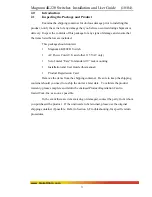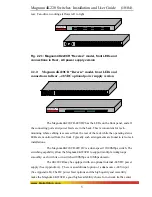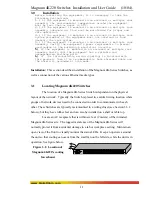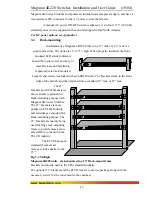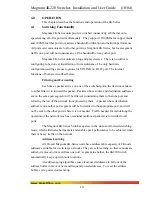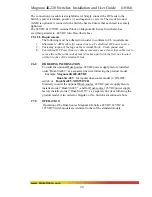
Magnum 4K220 Switches Installation and User Guide (10/04)
15
www GarrettCom com
.
.
4.2 Status
LEDs
For Magnum 4K220 models :
PWR :
Power LED, ON when external power is applied to the unit.
Link/Act :
Steady ON for link with no traffic, blinking indicates port is
transmitting and receiving.
FDX/Col :
Full / Half duplex LED, steady ON when the port is running
full duplex, blinking for collisions
100/10 :
Speed LED, ON when the speed is 100Mbps , OFF when the
speed is 10 Mbps
4.3
Up-link Port, for RJ-45 Port #39 (only)
Magnum 4K220’s each have one Up-link port, port # 39, with a thumb
operated slide switch for regular (=) or crossover (X) connections. The Up-link port
allows non-node (switch-to-repeater, switch-to-switch, etc.) connections without a
special cross-over cable. It works the same for 10Mb or 100Mb connections.
Use port #39 in the = position (or ports 1 thru 40) for straight-through
twisted pair cabling from the 4K220 switched port to a user device. Use port #39 in
the “X” port for cross-over or up-link segment connections to a repeater or hub or
switch. Verify proper port connection by noting the port’s LINK/ACT status, which
is illuminated when a proper link is made, and is blinking when there is activity.
4.4
Auto-negotiation for RJ-45 (copper) ports
The 4K220CR Switch’s RJ-45 copper ports are N-way auto-negotiation.
There are 4 different speed and F/H modes selection depending on what the other
device supports. These are: (1) 100Mb full-duplex, (2) 100Mb half-duplex, (3) 10 Mb
full-duplex and (4) 10 Mb half-duplex.
The auto-negotiation logic will attempt to operate in descending order and
will normally arrive at the highest order mode that both devices can support at that time.
(Since auto-negotiation is potentially an externally-controlled process, the original
“highest order mode” result can change at any time depending on network changes that
may occur). If the device at the other end is not an auto-negotiating device, the 4K220-
Switch’s RJ-45 ports will try to detect its idle signal to determine 10 or 100 speed, and
will default to half-duplex at that speed per the IEEE standard.



